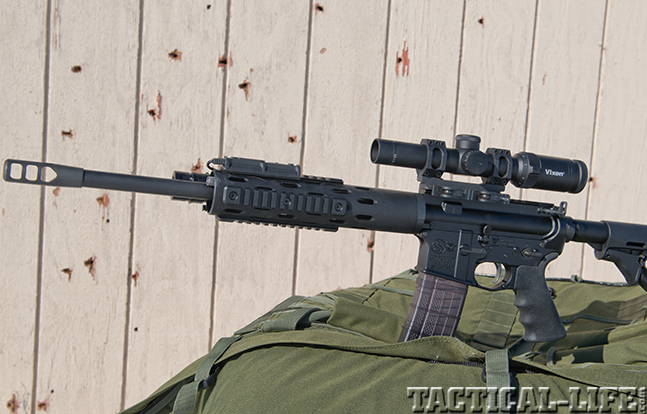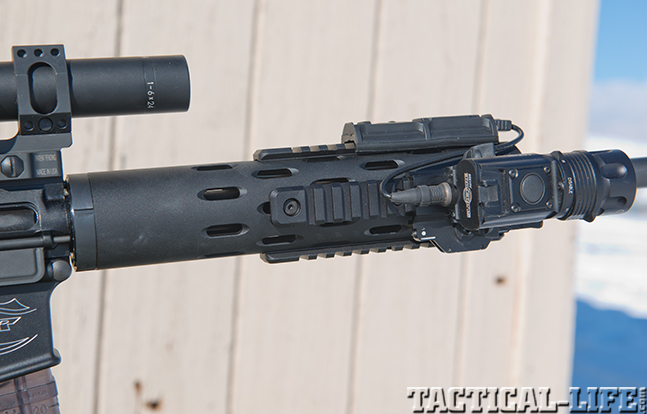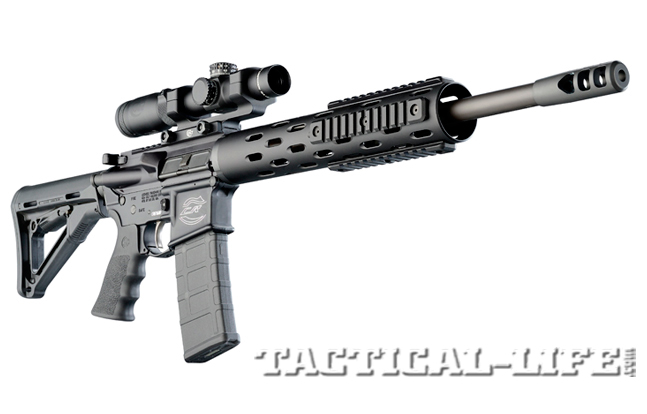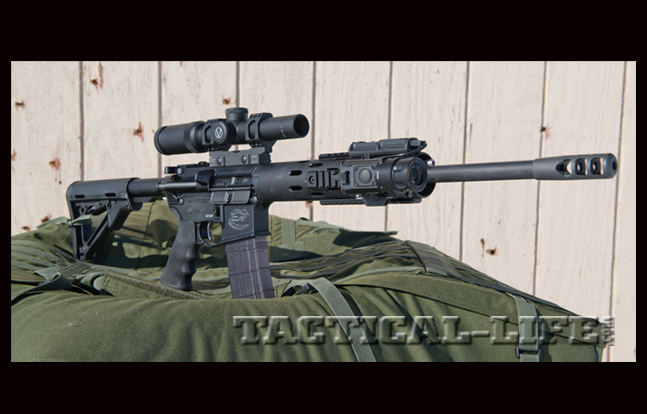Although I came late to the 300 Blackout bandwagon, it has become one of my favorite calibers for tactical and duty use. While recognizing the convenience and logistical viability of the 5.56mm, it has never been my preferred patrol or SWAT rifle cartridge. Like all calibers these days, it has benefitted from advancements in ammunition design, but it remains a “caliber of convenience” to me. Given its military and NATO use, it is prevalent, relatively inexpensive and easy to shoot. Essentially, it gets the job done, is easy for departments to get and weapons chambered for it are prolific. Its characteristics and limitations are well known and tested, making them easily adopted into policies and procedures. But, while this makes it easy for departments and officers to get a rifle that will get the job done, it does not mean it is the best caliber for the job.
More from Colt: Colt’s M2012MT308T ‘Invests’ in Rugged, Lightweight Stock
Over the years, I’ve tested many calibers while working as the sergeant and later lieutenant in charge of department firearms training. My preferred caliber in terms of effectiveness was the 7.62x39mm, but politics and weapons availability were never going to let that happen. The 6.8 SPC, a caliber I’ve used for years, was another favorite. Short of a 7.62x51mm, it remains my preferred carbine cartridge over the 5.56mm. Yet, both of these calibers have challenges when it comes to operating in AR-platform rifles. The 6.8 SPC requires different magazines, and while there are a few good ones, they are anything but prolific or inexpensive. AR-style rifles in 7.62mm NATO are getting better, but when fielded with shorter barrels, some are less than 100 percent reliable.
Advertisement — Continue Reading Below
The introduction of the 300 AAC Blackout cartridge has changed this dynamic considerably. With the correct ammunition, it offers ballistics nearly identical to the 7.62x39mm. And because it utilizes 5.56mm bolts and magazines without any alterations, converting to the 300 Blackout amounts to a simple barrel change. Loaded with full-power ammunition, a well-built 300 Blackout rifle will run as reliably as the AR platform allows. It also works better with short barrels and suppressors, making it an excellent entry rifle that offers greater terminal ballistics at any reasonable police range. Its only drawback has been ammunition availability, and that is slowly changing, encouraging new companies to start building in this caliber. One such company is Bold Ideas Texas, the licensed manufacturer of Colt Competition rifles.
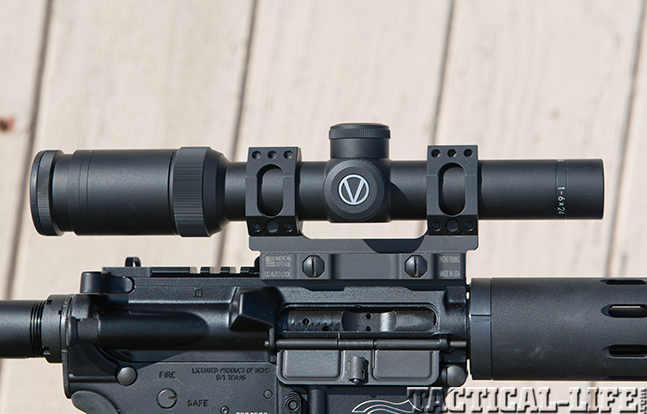
Originally located in Oregon, Bold Ideas is now in Texas and builds rifles geared toward 3-Gun under the Colt Competition name. It is the only company licensed to build competition rifles under the Colt name. Three-Gun competitions are excellent testing and proving grounds for equipment used for self-defense and duty, making crossovers pretty common. These weapons are really worked hard, especially at larger 3-Gun events, weeding out equipment and designs that are unreliable. Regular competitors run their rifles much harder and more often. These guns see more use in a season than many police department guns see in their serviceable lifetimes. Colt Competition rifles are no exception; they are beginning to make the transition to the “tactical” market, and the Colt Competition CRB-16RR in 300 Blackout is a solid example.
Gun Details
Advertisement — Continue Reading Below
The direct-impingement CRB-16RR starts with a forged, flattop upper receiver. Attached to that is a tubular forend with four removable rails that covers a Colt Competition adjustable, carbine-length gas system. No tools are required to adjust the valve in the gas block, and it is easily accessible. Within the handguard is a 16-inch, match-grade, 416 stainless steel HBAR barrel with a 1-in-8-inch twist rate and a SAAMI-spec 300 Blackout chamber. The muzzle has 5/8×24-tpi threading, and a Colt Competition Triple-Port muzzle brake comes equipped. The mil-spec bolt carrier is magnetic-particle (MP) inspected. Finally, the upper receiver features a Colt Competition charging handle with an extended latch.
The CRB-16RR’s forged lower receiver houses a Colt Competition match-grade trigger that is nickel-Teflon coated and breaks crisply at less than 6 pounds. A mil-spec, six-position, carbine-length buffer tube is used, housing a standard H-buffer and spring. Hogue’s rubber grip is mated to a Magpul oversized triggerguard. Magpul’s CTR stock rounds out the rifle. The CRB-16RR is shipped in a box with a nice cleaning kit, one 30-round PMag, a lock and a test target.
I added a Vixen Optics 1-6x24mm scope in an American Defense QD single-piece mount, which made it easy to attach and remove the scope with no loss in zero. The scope’s illuminated duplex reticle, positioned in the second focal plane, allows for better aiming at longer ranges.
Advertisement — Continue Reading Below
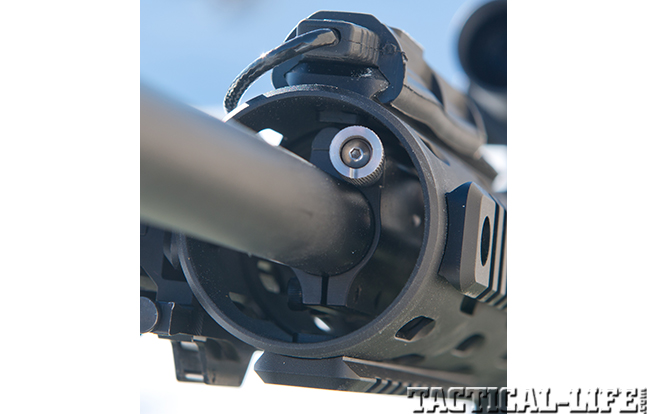
Mounting a sling was a bit problematic, as there was no way to attach it to the handguard. The tube is solid, with no built-in sling cups. The rails will accommodate several mounts, but none were provided. Since I had several Daniel Defense rail-mounted sling attachments in my shop, I added one for most of the CQB work.
All of the testing was completed with the SureFire M720V light attached. This light allows for either white or infrared lighting and uses a remote switch that can be easily attached to any rail. It can be activated using a momentary or constant-on switch. Designed for the military as a “do all” rifle-mounted light, the M720V can also be used as a handheld light. A button on the body allows for use with or without the rail-mounted remote switch. It is easily one of the most versatile tactical lights on the market.
Range Time
Advertisement — Continue Reading Below
The sample CRB-16RR came with a test target showing a group of Hornady 110-grain V-MAX rounds measuring 0.76 inches. My testing results were similar, with the best five-shot group measuring 0.86 inches using the same ammunition. Four of those five rounds were well under half an inch. This Colt was accurate, with everything tested yielding groups at or around an inch. Remington’s 125-grain Open-Tip Match (OTM) ammunition generally rules for 300 Blackout accuracy, but this rifle seemed to favor the 110-grain bullets by just a bit.
“… this rifle was fast, accurate and reliable. It was also very handy, especially at CQB distances.”
The tendency is to “over-gas” AR-style rifles so they work with most ammunition. Over-gassing amounts to making the gas port hole large, sending more gas to the bolt. Short of custom-tuned rifles, most AR style rifles are over-gassed liked this, whether they’re direct impingement or piston driven. It’s just a product of the market, since ammunition varies and there is no way for a builder to make its rifles work perfectly with everything. Adjustable gas blocks allow you to tune the rifle to your ammunition, however. Many direct-impingement adjustable gas blocks require the use of a tiny little wrench, and they often come loose. The adjustable gas block on this rifle is a really nice design. A large knurled knob protrudes from the forend. You pull it out, adjust it and push it back in. It allowed me to adjust this rifle so that it was very smooth with the Hornady ammunition, and it never came loose—it’s a very nicely designed setup.
Advertisement — Continue Reading Below
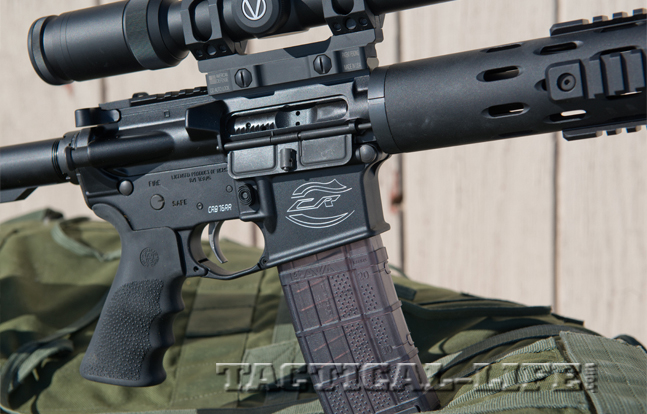
Theoretically, this gas block allows you to tune the rifle for subsonic ammunition. While the CRB-16RR ran better with subsonic ammo than most I’ve tested, it was still not duty reliable with any of this type of ammunition. Adding a suppressor would probably help. It cycled the 220-grain Remington and 208-grain Hornady loads well but would not lock open on the last round. A buffer spring change would likely allow these to function reliably. It would not cycle 240-grain loads.
With any of the full-power loads, this rifle was fast, accurate and reliable. It was also very handy, especially at CQB distances. The Vixen scope took some getting used to, but it was pretty fast once I was accustomed to it. The duplex reticle keeps this rig locked into 300 yards and in—maybe 200 yards with this caliber, unless you want to take the time to adjust the knobs. The 110-grain bullets usually drop about 8 inches or so depending on barrel length at 200 yards, making holdovers with no lines possible. That being said, at 100 yards and in, it was fast. With the illuminated dot for CQB distances, you are basically running a red dot. This scope also comes with a mil-dot reticle, which is probably a better choice for tactical uses.
More from Colt: LE901-16S: Colt’s Hunting Rifle for Medium to Large Game Animals
Advertisement — Continue Reading Below
Moving around the range, the CRB-16RR was well balanced and fast on target. The muzzle brake is also manageable as long as you are outdoors. Taming recoil and muzzle rise nicely, it remains loud. And it’s really loud indoors, as you might expect. If this rifle were to be actually fielded, you’d probably need to replace the muzzle brake with a flash suppressor of some kind. Using full-power ammunition, that is seldom an issue with this caliber, especially with a 16-inch barrel, so any solid flash suppressor will work. Every 300 Blackout rifle I’ve tested has run well with suppressors, so you can also use many of the thread-on suppressors, or those using quick-attach flash suppressors.
Final Notes
As Colt Competition moves into the tactical market, it looks to be a solid choice. This rifle was accurate, well balanced, reliable and pretty well equipped. The trigger was crisp and would fit well within most LE agency policies.
Advertisement — Continue Reading Below
The muzzle brake is problematic for me. I’ve heard all of the arguments, and none of them wash for me. If it is a fighting rifle, it needs to work in a close-quarters environment without taking your fellow officers (or you) out of the fight. Super-fast split times and muzzles that don’t move are way down on the “need” list for a 5.56mm or 300 Blackout rifle meant for duty use. As brakes go, this is an excellent one, and short of a suppressor it would be perfect for a competition, but my preference remains a proven flash suppressor for duty rifles or home defense. On the plus side, the 300 Blackout using full-power ammunition runs great with just about any of them, and the 5/8×24 threading will accommodate most.
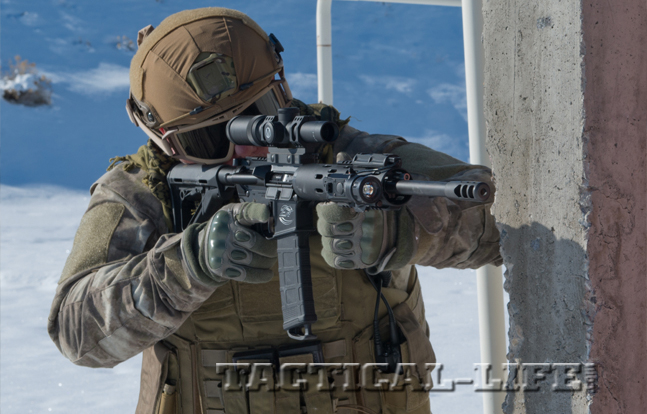
It would be nice to see some means to attach a sling. The CTR stock allows for use of QD sling swivels as well as standard attachments. Having rails on the forend allows for lots of choices; I would like to have seen one provided. Slings may not be allowed at 3-Gun competitions, but they are a must for any rifle going into harm’s way—it’s just nice to mount one right out of the box.
With just a few changes, it’s perfectly suited to its “tactical” name. It was as accurate as this platform gets short of a precision model. Its components and build quality are excellent. If you are looking at the 300 Blackout for a tactical rifle, this would be an excellent choice. Colt Competition has a solid reputation, and this rifle meets that standard nicely.
Advertisement — Continue Reading Below

